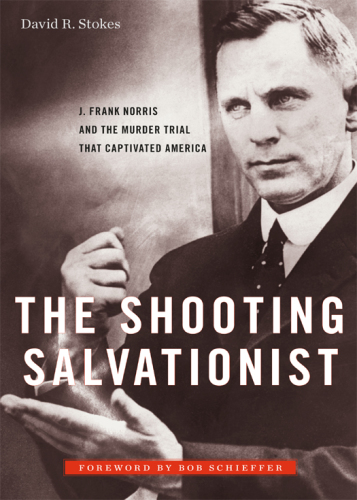
The Shooting Salvationist
J. Frank Norris and the Murder Trial that Captivated America
کتاب های مرتبط
- اطلاعات
- نقد و بررسی
- دیدگاه کاربران
نقد و بررسی

May 16, 2011
A leading fundamentalist figure in America in the 1920s, J. Frank Norris preached to an audience of nearly 6,000 in his First Baptist Church in Fort Worth, Tex. But his evangelical empire began to crumble when he shot a man and was tried for murder, a saga that minister and broadcaster Stokes unevenly cobbles together with a patchy history of the fundamentalist movement in the early 20th century. Positioning himself as the heir apparent to populist politician William Jennings Bryan, Norris favored showmanship and aggressively championed his causes, from alleging a Catholic conspiracy to a county wide ban on liquor. He was soon one of the most visibleâand polarizingâpublic figures in Fort Worth and had no qualms about butting heads with city officials. He became even more infamous on July 17, 1926, when he shot D.E. Chipps three times in his church office. The ensuing murder trialâNorris claimed self-defense (though unarmed, Chipps had threatened to kill Norris)âbecame a media circus, with Norris's eventual acquittal. But Stokes leaves the roots and consequences of religious zealotry as well as the questions posed by the intersection of law and religion largely unexplored. 16 pages of illus.

May 1, 2011
Account of a highly publicized 1926 murder in Fort Worth, Texas, and the trial of accused killer J. Frank Norris, a fiery fundamentalist preacher.
Norris, whose Fort Worth church reputedly attracted more parishioners than any other in the United States during the 1920s, preached a gospel of hatred against African-Americans, Catholics and other targets. Using a newspaper he founded and a radio station, he reached audiences in a similar manner as Jerry Falwell decades later. Regularly inserting himself into controversies about the direction of Fort Worth government and business, Norris collected enemies and friends with equal aplomb. A lumber tycoon named Dexter Elliott Chipps became one of the enemies. One day in 1926, Chipps, known for his drinking, womanizing and large physical presence, called Norris at church to announce he would be walking over for a talk. When he arrived, Chipps apparently warned Norris to withdraw certain criticisms of Fort Worth leaders. Claiming to fear for his life, Norris pulled a gun and shot the unarmed Chipps dead in the church office. The criminal trial moved from Fort Worth to Austin because of prejudicial publicity. Journalists from around the nation and world covered the trial, which centered on the question of whether Norris had killed Chipps in self-defense. The jury acquitted Norris, who then remained active in fundamentalist church circles and right-wing political circles until his death in 1952. Sharing the spotlight in the narrative are the Chipps family members, church employees and congregants loyal to their minister, Fort Worth social and political big shots and well-known lawyers on both sides of the case.
A mostly chronological account based on thorough research but marred by repetition and a melodramatic tone.
(COPYRIGHT (2011) KIRKUS REVIEWS/NIELSEN BUSINESS MEDIA, INC. ALL RIGHTS RESERVED.)

June 15, 2011
Stokes, a minister himself, tells a long-forgotten story that captivated America in the 1920s. Today's charismatic preachers have mastered the use of media; J. Frank Norris was a pioneer. Norris's First Baptist Church in downtown Fort Worth, TX, drew 5000-6000 parishioners each week to his Sunday morning and evening services. He published the weekly Searchlight newspaper and broadcast his sermons on his radio station. He traveled around the country holding revival meetings and was poised to succeed William Jennings Bryan as a national fundamentalist leader, but then he killed someone. Most of the book relays Norris's murder trial for killing a local businessman who was angry over Norris's constant verbal attacks on city leaders. The trial was such a big news story that telegrams were sent constantly from the courthouse during the proceedings. VERDICT Readers will enjoy this oversize tale--a snapshot of a fascinating time in American and Texas history--that reads like fiction. It will appeal to those interested in true crime, the history of fundamentalism, and the early days of Texas.--Karen Sandlin Silverman, Ctr. for Applied Research, Philadelphia
Copyright 2011 Library Journal, LLC Used with permission.

Starred review from June 1, 2011
After the 1925 death of William Jennings Bryan, the hugely popular politician and anti-evolution campaigner, one man seemed poised to step into his shoes, Fort Worth fundamentalist preacher J. Frank Norris, whose fire-breathing sermons and enthusiastic championing of the common man had made him famous across the U.S. But in 1926, his crusade was derailed when he was charged with the murder of a man who, Norris claimed, had threatened his life. This excellent book chronicles the court case that, even if it's barely remembered today, captivated the nation, and it makes its central player as compelling and multilayered as any character from fiction. Stokes says the book is not merely based on a true storyit is a true story. All dialogue comes from documented sources and is presented verbatim. All events are based on the historical record. At a time when creative nonfiction is becoming ever more prevalent, it's refreshing to see a biographical work in which what you read is what actually happened and what is said is what was actually said. Engagingly written in an immediate, you-are-there style, the book is as compelling and surprising as any Grisham thriller. Top of the line.(Reprinted with permission of Booklist, copyright 2011, American Library Association.)

























دیدگاه کاربران